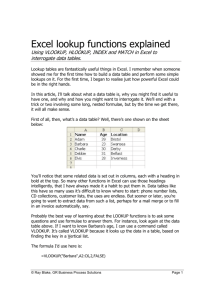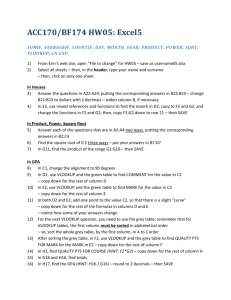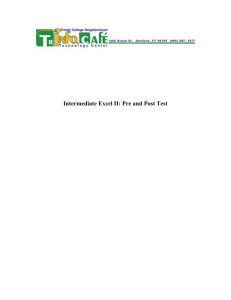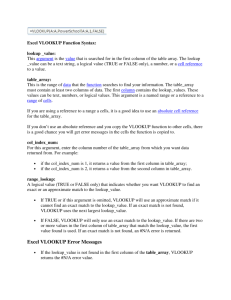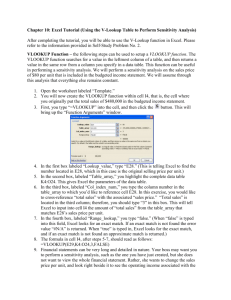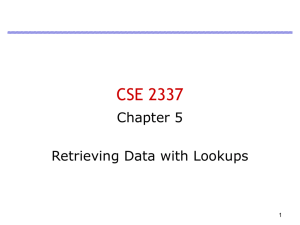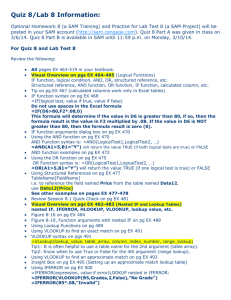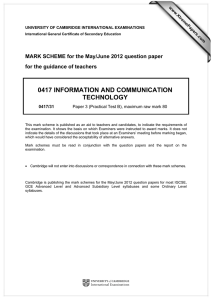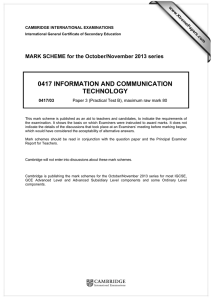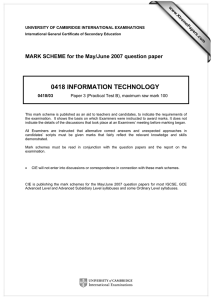Using VLookup
advertisement
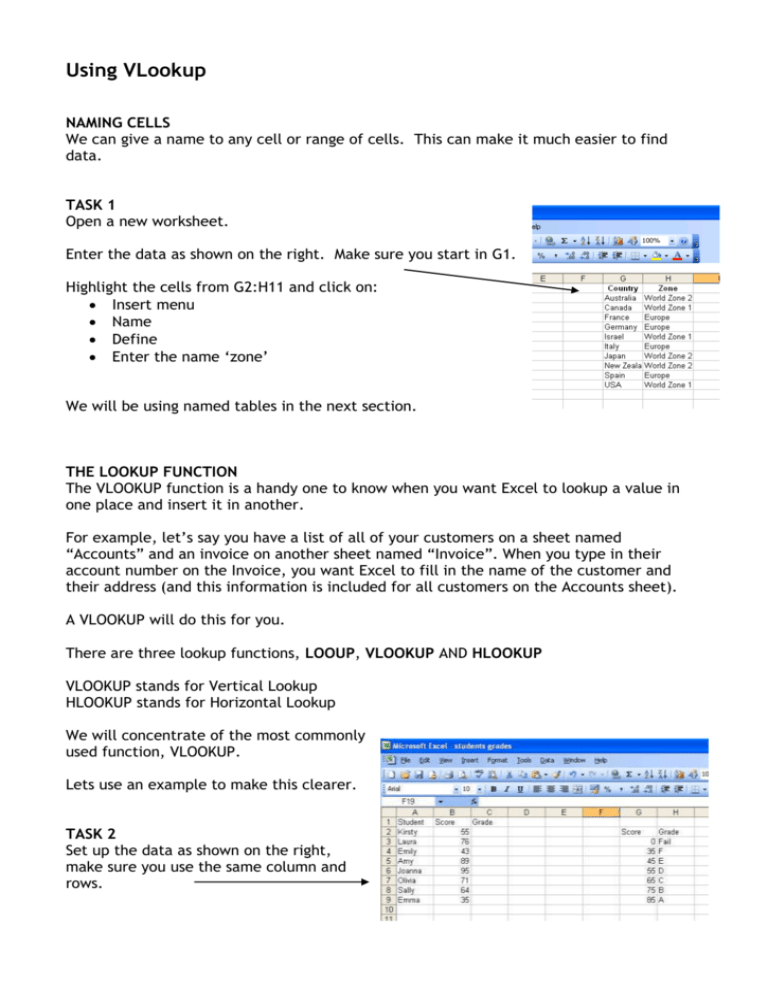
Using VLookup NAMING CELLS We can give a name to any cell or range of cells. This can make it much easier to find data. TASK 1 Open a new worksheet. Enter the data as shown on the right. Make sure you start in G1. Highlight the cells from G2:H11 and click on: Insert menu Name Define Enter the name ‘zone’ We will be using named tables in the next section. THE LOOKUP FUNCTION The VLOOKUP function is a handy one to know when you want Excel to lookup a value in one place and insert it in another. For example, let’s say you have a list of all of your customers on a sheet named “Accounts” and an invoice on another sheet named “Invoice”. When you type in their account number on the Invoice, you want Excel to fill in the name of the customer and their address (and this information is included for all customers on the Accounts sheet). A VLOOKUP will do this for you. There are three lookup functions, LOOUP, VLOOKUP AND HLOOKUP VLOOKUP stands for Vertical Lookup HLOOKUP stands for Horizontal Lookup We will concentrate of the most commonly used function, VLOOKUP. Lets use an example to make this clearer. TASK 2 Set up the data as shown on the right, make sure you use the same column and rows. Our students have been given an exam mark. Their teacher wants an easy way to find out which grade they should be assigned. It is much easier to use a VLOOKUP if the table you want to look up from has been named. Highlight cells G3:H9 Name these cells as ‘grades’ You are going to write your VLOOKUP formula in cell C2. You want to look at the mark that Kirsty gained and find out which grade she should be given. Click into cell C2 Click the fx icon This screen will appear. Click on the arrow next to category and select ‘all’ in order to get all of the functions to appear. In the section called ‘select a function’ scroll down until you see VLOOKUP, click it and then click OK. This screen will appear: In the first section ‘Lookup_Value’ you need to tell it what you want to look up. Click on the blue and red button to the left hand side of the section. This will allow you to see your tables. The ‘Function Argument’ box will appear Click into B2 and press ‘Enter’. If Enter doesn’t close the Function Argument box then press the red cross. B2 should now appear in the ‘Lookup_value’ In ‘Table_array’ you need to enter the name of the lookup table that you created, in this case it is grades The third section, ‘Col_index_num’ is asking which column you would like to return. If you look at your grades table, it is column 2 (you will find with most lookup formulas that you are asked to write, it is usually column 2). Notice the last box is labeled "Range_lookup" and it is the only label that is not bold. Whenever a label in this wizard is not bold, that means this "argument" of the function is not required, so you can leave this blank if you choose to. However, if you do not enter anything in this box, Excel will apply the default. If you read the instructions at the bottom of this box, you will see that the default for this box is "true" which will find the "closest match", whereas "false" will find an "exact match". We are going to leave it blank this time. Your VLOOKUP formula should look like this: Press ‘OK’ You should find that D is returned in cell C2. Drag the VLOOKUP formula down to cells C3:C9 You should have the following results: Kirsty Laura Emily Amy Joanna Olivia Sally Emma 55 D 76 B 43 F 89 A 95 A 71 C 64 D 35 F Lets try another example. TASK 3 Open a new worksheet. Enter the data as shown on the right. Make sure that you use the same columns and rows. Draw a border around your tables – use a thicker outline and thinner gridlines. Centre align B:3:C:10 and F3:F7. Use different background colours for each table. Make the headings bold as shown. Highlight cells F3:G7 and name the table sizes You are going to write your VLOOKUP formula in cell C3. You will be looking at B3, and comparing it against the table you named as ‘sizes’ and then returning the correct value in C3. Click on the Fx button. Find VLOOKUP. Lookup_Value – which cell are you looking at? Table_array – what did you name your table? Col_index_num – do you want column 1 or 2 to display? (remember it is usually column 2) Have a go at the formula and see what happens. Mr Smith should have a ‘medium’ waist. Drag the formula down for cells C4:C10 The formula should have looked something like this: And your results should be these: Customer Waist size Mr Smith 33 Mr Jameson 29 Mr Peters 34 Mr Brown 39 Mr Fletcher 46 Mr Field 52 Mr Payton 35 Mr Edmunds 30 Size Medium Small Medium Medium Large XL Medium Medium TASK 4 Modify the Marks spreadsheet (TASK 2) so that it not only looks up the associated grade letter, but also a suitable comment. EXAMPLE: 80-100 Comment should be "Excellent Work!", 70 - 80 "Good Work", etc. TASK 5 – BONUS Using your CD-Royalty Spreadsheet, use the Royalty Rate to give one of three possible comments: High, Medium, Low. Put this in a column that you insert between the Rate and the Payment columns. You decide what the high, medium and low amounts should be, but an example of each should appear in the new column.

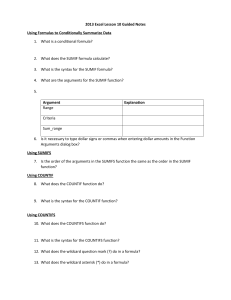

![VLOOKUP ([Score], A5:B10, 2)](http://s3.studylib.net/store/data/007008406_1-329b439ee1a3b5923ce08e77bb280c5d-300x300.png)
